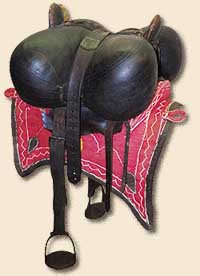Initially,
Georgian riders joined the Buffalo Bill’s Wild West show in
1892, traveling to London that year and to America in 1893. Of all
the tales told about the riders, the one most often repeated is
the story of their recruitment. Thomas Oliver (1867
– 1943), a commissioner, arrived in Georgia (then part of
Russian Empire) to locate riders for Wild West show in the United
States. In Batumi, Oliver stopped at the home of James Chambers,
the British Council. An employee of Chambers, a fellow named Kirile
Jorbenadze, who was on familiar terms with some of the riders in
Guria, offered help. Oliver accepted and soon the two men plus vice-council
Harry Briggs, departed to the village of Lanchkhuti. On the way
there they stopped at village of Bakhvi, where they visited Ivane
Makharadze, a distinguished rider who promised Oliver that
he would be responsible for signing up other riders. Thomas Oliver
was a remarkable character. Born in Manchester, in a family of circus
performers, he spent his childhood on the road with his parents.
Perhaps that's how he ended up spending some time in Tiflis. During
the following years, Oliver traveled across the Russian Empire with
various circuses and became familiar with the Georgians’ riding
skills. This implies that he didn't come to Georgia “blindfolded.”
Later, he interpreted for the Georgian riders (1892-96) presumably
in Russian or quite possibly, in Georgian. |
|||
|
|
|||
| Georgian riders in London 1892 | |||
The
British newspaper, The Weekly Dispatch reported its first account
of the Cossack riders in Wild West show on May
8, 1892. That was the riders' first documented trip to England.
Similar, but shorter account of that trip appeared in the Georgian
newspaper Iveria. It recorded briefly, “Batumi: here's the
list of Georgians, taken to London by a French agent: Ivane Makharadze,
Dimitri Mgaloblishvili, Vaso Ckhonia, Levanti Jorbenadze, Luka
Chkhartishvili, Mose Gigineishvili, Irakli Ckhonia,
Besarion Tsintsadze and Meliton Tsintsadze. Ten persons, all in
all.” In an interview granted to The Oracle (May 28, 1892),
Nate Salsbury, the Wild West show's general manager, confirmed,
“Yes, they arrived last night. They come from beyond Tiflis
(Now Tbilisi, the capital of Georgia), near the extreme of the Caucasus
Mountains. They are headed by Prince Ivane
Makharadze…”(Group
leaders were mostly referred to in the lists as "Prince".
In fact, only some of the riders were of noble origin. The rest
were mostly peasants. Apparently, it was a publicity stunt to attract
more people) By that time, the British were well aware of Buffalo
Bill's traveling extravaganza. The show had
been introduced to the English public at Queen Victoria's golden
jubilee in 1887. It was a smash, despite having no so-called, “Cossacks”.
|
|||
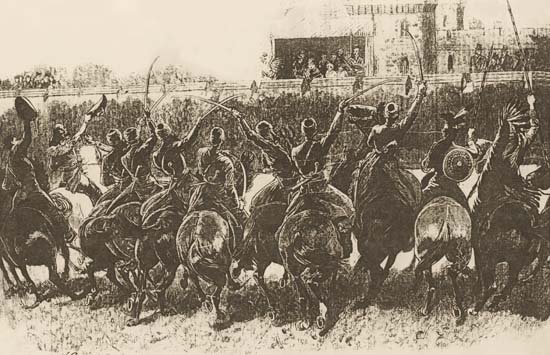 |
|||
Buffalo Bill and Georgian riders in Windsor |
|||
On
June 25, 1892 the Georgians, lead by Ivane Makharadze, performed
in front of the Queen, the royal family and other members of the
aristocracy. Charmed by the performance, Her Majesty, Queen Victoria
presented the Georgians with a gold engraved album with photos of
their performance. (Presumably, the album was kept at Ivane Makharadze's
house in Guria and was destroyed during a fire) and the British
society expressed gratitude by issuing a letter of gratitude signed
by 20, 000 people. |
|||
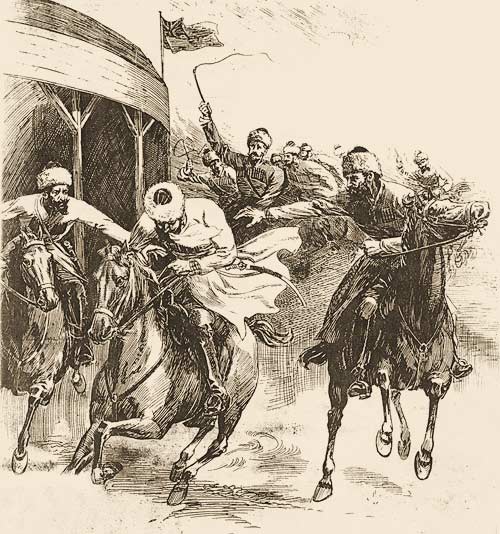 |
|||
| Prince Ivane Makharadze and his troop of "Cossacks" performing their lively feats | |||
The Wild West show organizers initially paid little attention to the riders' origin, identifying them Russian Cossacks, Russian Caucasus Cossacks or even Caucasian Jews. It might be worth mentioning that Thomas Oliver and other organizers were responsible for creating this initial mystery in the media by declaring that the riders came from the southern part of the Russian Caucasus, where the Cossack family in Lord Byron's "Mazepa" came from. Even the riders boasted that they were awarded medals for bravery but it was a con, of course. Other newspapers went even further, such as The Hutchinson Leader that ran an article on July 24, 1908, “The Cossacks were the real thing, right from the Czar’s army. Splendid horsemen and brave fighters, they are also fierce and cruel. They were members of the same regiment that charged upon a throng of men, women and children in the streets of St. Petersburg two years ago and shot and sabered, murdered, a thousand.” No wonder such stories helped make them popular heroes. |
|||
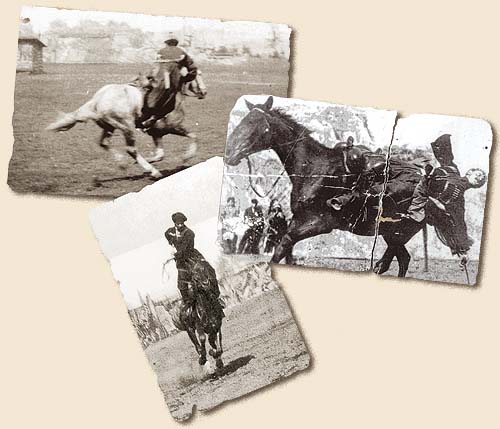 |
|||
|
These saddles were not cheap, an ordinary Cossack saddle cost $75, and the one custom made for Alexis Georgian cost $275. |
Georgian
riders were known to do the most unbelievable stunts while galloping.
Sarah J. Blackstone wrote that the horses needed some time to get
used to the tricks performed by the "Cossacks". Some Georgian
sources claim, rather unconvincingly, that they rode the Georgian
breeds. According to The London Start (May 31, 1892), “Their
riding consists mainly of tricks on horseback, and I’m very
anxious to see what they can do in that line. We cannot try them
yet, as their wiry little horses need rest after their long journey.”
But these comments don't correspond to reality. First, it was very
expensive (around $320) to transport a horse across the Atlantic
and second, it was prohibited by quarantine regulations. Normally
all the horses were sold after the shows were over in Europe. This
indicates that either it was costly for the organizers or prohibited
by existing regulations to ship them across the Atlantic. |
||
 |
|||
The
act usually began with Georgian native dances and songs, and then
was followed by stunt riding. It represented the perfection of man
and horse and the Georgians did some unimaginable things. Even William Cody himself said in one of his interviews, "Ride?
They can ride anything, and if they get thrown they are up again
in a flash. You can’t tie’em down.” (New York
Daily Tribune, April 20, 1902).
|
|||
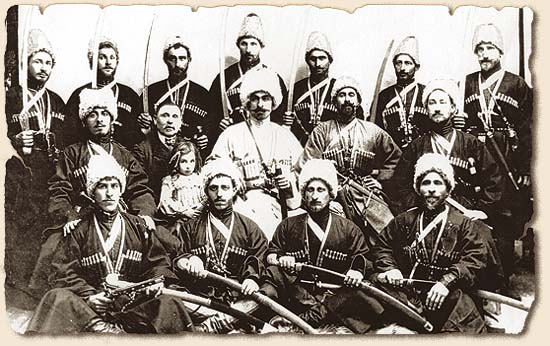 |
|||
| Georgian riders, circa 1900 | |||
| The
First World War and the Bolsheviks ended the Georgians' voyages abroad.
Those Georgians who found themselves stuck in the States, mostly in
Chicago, continued performing in Miller and Ringling Brothers' circuses
and returned to their homeland only when the war was over. Many Georgians
settled down to create typical American families and lost ties with
their homeland. As the century progressed, many Wild West shows had to compete with new entertainments, including motion pictures. Some of the shows' organizers, including Buffalo Bill, started to make film versions of the shows but despite these most of the shows were in deep financial trouble due to declined attendance. The occasional feeble attempt by some to reanimate the previous glory of the shows led to tasteless endeavors in which some of the Georgian original participants were enlisted. But by that time they had lost the luster of stardom along with their energy and endurance. Fatally, the media had lost interest in them. The organizers even stopped mentioning their names in the programs. Hard times were ahead for those who returned to Georgia as well. On the grounds that they all were American spies, most of the riders were imprisoned and exiled by the Bolsheviks. Many riders had to destroy all evidence and photographs of their trips abroad in order to survive the new regime's iron hands. There were cases when riders were forced to sign a document in which they promised never to mention America or Europe again. The Bolsheviks confiscated all the precious gifts and present they had been given. Usually, these things surfaced in the houses of the party nomenclature. Nervous stress was too much for many, - some committed suicide, others died in oblivion... |
|||

